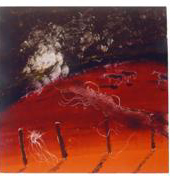 
|
 |






|
 Proust likened memory to sediment — years of events, senses and emotions condensed into a mixed, multi-layered block within the mind. Recalling the past, then, involves painstaking excavation or sudden, haphazard discovery. The elusive nature of memory is the subject of much of Judith Bever's work. Coupling monoprint with brush work, using the printing press as a tool that marries pigment with paper and allows her to build her pieces layer upon layer, she creates a density and depth of superimposed images akin to our memory-cluttered minds. Her pieces are cubes of crystallized experience; she is both painter and excavator.
Proust likened memory to sediment — years of events, senses and emotions condensed into a mixed, multi-layered block within the mind. Recalling the past, then, involves painstaking excavation or sudden, haphazard discovery. The elusive nature of memory is the subject of much of Judith Bever's work. Coupling monoprint with brush work, using the printing press as a tool that marries pigment with paper and allows her to build her pieces layer upon layer, she creates a density and depth of superimposed images akin to our memory-cluttered minds. Her pieces are cubes of crystallized experience; she is both painter and excavator.A pleasingly round arch (a hill? a horse's neck? both?)...a barbed fence torn and fading from the illuminated foreground into blurred darkness...two horses, rumps echoed in the rising slopes beyond them...three trees standing alone against a bright horizon. The bold archetypal images of Judith's paintings evoke an inexplicable sense of something seen before, an inkling of familiarity. Her horses (inspired by a childhood of riding hell bent for leather across the flat land of South Dakota) have an intrinsic and mythic appeal regardless of one's particular experience, or lack thereof, with the creature. In "Bath Tub — Housing Project 1950", a childhood photograph of a bathing child seems captive within the dark paint, buried beneath the foreboding layers of print and shape. Resonating from and beyond Judith's personal snapshot is the emotion — the fear and confusion that is as much a part of childhood as the wonder of joy (the subject of the companion piece ("Out at the Ranch, Happy Trails".) Looking at one of Judith's mixed media prints imitates the experience of remembering, they are evocative of recollection itself. In "Sacred Land", the primitive outline of a horse seems enclosed in a bubble, suspended above the land, seen as part of the landscape only when recalled much later. The ground at the base of this painting is shadowy and seems a deep liquid — a sea of land like the constant flux and flow of the grassy earth of Judith's childhood memory. "There are Three Trees" depicts a pure, crystalline sky, a golden arch of land with three trees perched at its edge and a winding path leading up and away, fading into the dreamy distant sky. The natural complement of sky and land, the organic perfection of the three tree composition and the path that takes us to the heavens — these are the essential and lasting bits of memory. In recollection, certain things come forward, others disappear and our imagination intervenes to fill the gaps. The petroglyphs of La Cieneguilla — ancient markings that speak to the timeless and universal nature of picture and expression — inspire much of Judith's recent works. In "Paints" her brush strokes seem to spill from the markings of the horses across the painting — an homage to the artistry already present in nature. Judith's art aspires to the natural beauty that abounds and yet is so rarely viewed with such keen perception. She remained devoted to uncovering, to seeing deeper and feeling deeper and reforming the treasure she unearthed with a truly organic method of painting. — Erin Wade |